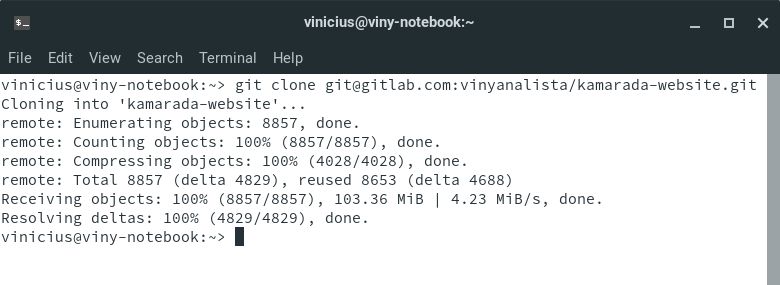

- GIT CLONE COMMAND USERNAME PASSWORD HOW TO
- GIT CLONE COMMAND USERNAME PASSWORD UPDATE
- GIT CLONE COMMAND USERNAME PASSWORD PASSWORD
Most Unix/Linux users will already have an SSH key pair created and configured in their home directory and upload the existing public key.
GIT CLONE COMMAND USERNAME PASSWORD PASSWORD
In general, it generates a compatible public/private key combination on the machine and uploads the public key to your Git server. Git will sometimes need credentials from the user in order to perform operations for example, it may need to ask for a username and password in order to. Using command line, when users are trying to clone their repositories, they are able to go an SSH clone (by SSH key added into Gitlab). The process for configuring SSH keys varies slightly for each Git server.
GIT CLONE COMMAND USERNAME PASSWORD UPDATE
The easiest way to enable SSH for a Git repository is to use SSH for the protocol when cloning it: $ git clone :group/project.gitįor an existing repository, we can update the remote with the following command: $ git remote set-url origin :group/project.git They also require additional steps to set up SSH keys on both the server and client, which can be cumbersome in large organizations. Some networks or proxies may block these ports, making communication with the remote server impossible. The main downside to using SSH is that it uses non-standard ports. In Git, we clone an existing remote repository to our local machine using the command git clone.
GIT CLONE COMMAND USERNAME PASSWORD HOW TO
Learn how to connect to GitHub with SSH here.SSH keys are harder to guess than a password and can easily be revoked if they become compromised. Using the SSH protocol, you can connect to GitHub without supplying your username or password every time. However, due to security reasons, it is advisable that you use SSH to interact with GitHub, especially if you work for a company or you’re using a computer that isn’t yours. Git config -global credential.helper 'cache -timeout=600'īingo, you just fixed it, Git will never ask for your credentials again.
Git remote set-url origin Make Git store the username and password and it will never ask for them.

In this article, I’ll show you how to fix this. If the username and password are correct, the cloning of the remote repository begins immediately. Have you ever encountered Git asking you for your username and password every time you try to interact with GitHub even after configuring it? Well, this is a very common problem among users who use the HTTPS clone URL for their repository. git clone The username johndoe and the password mypass123 is provided in the remote url with the git clone command.


 0 kommentar(er)
0 kommentar(er)
